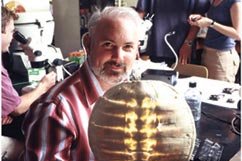The Wagner Free Institute of Science in North Philadelphia will host a lecture on intersexuality at 6 p. m. April 16.
Dr. Scott Gilbert, Howard A. Schneiderman professor of biology at Swarthmore College, will present “Putting the X and Y in SEXY,” a look at how chromosomal genes turn people into men, women or sometimes both.
Gilbert explained that intersexuality is the idea that a person is born with a reproductive system or sexual anatomy that does not conform to the binary definitions of male or female.
“Usually a person with an XY chromosome set develops as a man — with testes, male vocal muscles, male hair pattern and very little breast development,” he said. “In androgen-insensitivity syndrome, the XY person has a mutated androgen receptor protein. This is the receptor protein that is activated by testosterone and binds to the DNA to activate (or repress) testosterone-sensitive genes.”
But, since the receptor protein doesn’t recognize testosterone, the male “secondary sex traits” — such as elongated penis, descent of the testes and regression of breast tissue — don’t develop.
“So even though a person is genetically male (has a Y chromosome), their testosterone won’t work, and their estrogens do. Thus, the person looks female,” Gilbert explained.
Gilbert said he has always found the study of intersexuality to be a captivating topic.
“I find sex determination to be one of the most fascinating areas of embryology,” he said. “All other organs can be one thing or nothing — be a lung or not, be a kidney or not. The gonad precursor has two fates — be a testis, be an ovary or not.”
The concept of intersexuality shows that biology “isn’t digital” or black and white.
“It’s not a matter of A or B. It’s often a matter of some A and some B,” he said. “There’s a continuum, and we tend to recognize only the two extremes.”
Gilbert said there is ongoing debate in medical circles about whether intersexuality should be considered a “disease,” among other issues.
“It’s difficult to say, because the people are quite healthy. It doesn’t usually harm them,” he said. “However, they are sterile. Can they have children? Yes, but like many people, they will have to adopt them. So ‘intersex’ conditions make people think about how they view the world. Even the word ‘intersex’ is under debate, because some people think that this accepts the binary notion of sex traits.”
Intersexuality and LGBT identity aren’t inherently connected, but the two often have similar social implications, Gilbert said.
“I think that this is something that the LGBT community has to think about,” he said. “Homosexuality and intersexuality are not on the same axis. However, since both the intersex and the LGBT communities have to deal with social views that expect a complete alignment of all sex and gender categories, they may have many common battles to fight.”
Gilbert said conversations around sex and gender should go far beyond chromosomes.
“The construction of gonads and the elaboration of hormones by those gonads, and the reception of those hormones by the other bodily tissues all interact to generate sexual characteristics,” he said. “Moreover, nature has many variations, and humans are a diverse group that contain many variations on male and female anatomies.”
Gilbert’s lecture, at 1700 W. Montgomery Ave., is free to the public; however, registration is required.
For more information or to register, visit www.wagnerfreeinstitute.org.

